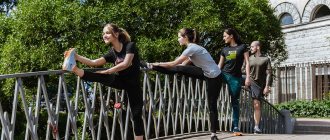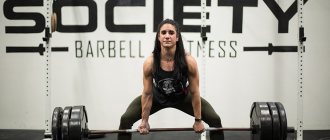When practicing any sport, the athlete’s attention will inevitably come to better recovery, optimal planning of mesocycles and getting into peak shape at the right time. All these tasks are related to the topic of supercompensation. This phase of increased performance when performing repeated work was first described by B.S. Gippenreiter in 1953.
Supercompensation plays a major role in the recovery process after training. During this period, there is an increase in sports results. The principle of supercompensation is applied in every sport, which will allow you to achieve the desired effect from training.
What is super compensation
Supercompensation is a period when already trained muscle tissue becomes powerful. The recovery process takes different periods of time. Muscle fibers are restored over a long period of time. When they increase, then muscle mass increases.
The speed of the onset of the supercompensation phase determines the optimal time when it is necessary to increase the sports load. By increasing the training load, not only muscle tissue increases, but also the body's endurance indicators increase.
Muscle growth or hypertrophy is an adaptation process of the body to changing conditions. The stress you experience during muscle training should increase with each physical activity.
To ensure this process, the muscles must be even stronger at the start of the next workout, when the muscle tissue has gained strength. During a planned workout, microtraumas occur in the muscle fibers, and during the recovery period the body begins to restore them.
Supercompensation in bodybuilding
In order for your performance and achievements in lifting sports to increase, during the super recovery period you must perform with greater efficiency and productivity than in the last training session. To do this, each session you need to increase the working weight, at least by a minimum, this is called load progression.
The duration of proper “training” should be between 40-60 minutes. Exceeding the specified time can lead to unnecessary strain on the muscles and expose the body to additional stress. Rest between loads (sets) – no more than one or two minutes. The approaches themselves should be quick, lasting no more than 40-60 seconds. This time is enough to use up all the glycogen.
The supercompensation system is a rather complex concept. Its stability is influenced by many factors, the combined action of which is very difficult to take into account. You can only find your peak super-recovery phase experimentally. The main thing is to try to get more rest, otherwise you will go astray and begin to regress towards overwork. This will only distance you from your goals and new sporting achievements.
Three phases of recovery
According to Gippenreiter, there are three main phases of performance recovery (wiki) after performing the first work before fatigue:
Active recovery phase
The launch begins after training and continues for half an hour. At this moment, the body restores the normal function of the systems. The glycogen supply returns to normal, the heart rhythm is restored and the hormonal system is normalized.
Moderate recovery phase
During the launch of this phase, the body enhances the production of amino acids, enzymes, and restores electrolyte balance. The digestive system better absorbs the nutrients needed to build new body cells.
Supercompensation phase
It begins on the second day after the training process and lasts five days. At this time, you need to play sports, training your muscles, to increase mass.
Delayed recovery phase
The physical parameters of the body are restored to their original level. But provided that there was no physical activity in the supercompensation phase.
Supercompensation[edit | edit code]
Super compensation
Super compensation
— the post-training period, during which the trained function/parameter has a higher rate compared to the initial level.
The supercompensation phase was first described by B.S. Gippenreiter in 1953 in his work.
According to scientific data, there are three main phases of recovery after training:
- the first phase is the recovery phase, during which tissue repair occurs, during this period the function is restored to its original level
- the second phase is supercompensation, during which increased performance is observed, which can exceed the initial level by 10 - 20%
- the third phase is the phase of gradual return to the original level of performance.
The principle of training planning
Repeated performance of muscular work - physical exercises over a number of days and months leads to an improvement in function or an increase in the trained parameter (muscle mass), which determines the possibility of physical development and improvement of a person.
In bodybuilding, you need to strive to ensure that each subsequent workout falls at the peak of the supercompensation phase. At first glance, this seems like a simple task, but supercompensation occurs at different times in different people, and there are no simple objective measures to identify it. Another problem is that when it comes to gaining mass or increasing strength, there are a number of parameters that become supercompensated at different times, so training frequency is very important in bodybuilding.
Read the main article:
Optimal training frequency
Solving the problem of supercompensation[edit | edit code]
To solve the problem with a number of parameters, supercompensation of which occurs at different moments, it is proposed to divide the training program into microcycles, where each microcycle is responsible for the development of a certain parameter. The simplest solution is split training, which should be performed in different intensity modes. That is, each muscle group should be trained with varying degrees of intensity from one session to the next: light - medium - high - and so on, read periodization for more details. Thanks to this approach, it is possible to maintain different parameters in the compensation phase and prevent the development of adaptation to loads.
Criticism[edit | edit code]
Professor Viktor Nikolaevich Seluyanov believes that the concept of “Supercompensation” is built on false grounds
Bodymaster.ru recommends Training Plans:
At this moment it is necessary to train. If the moment of supercompensation is missed, then the indicators return to the previous level and the meaning of the training will no longer exist.
In order to consistently progress, it is necessary that each training session coincides with the peak of supercompensation. But this period is difficult to determine, since there are no identifiers in supercompensation.
It is different for each athlete and depends on age, level of physical fitness, and genetic predisposition.
In bodybuilding there is the concept of training frequency. To get into the compensation phase, you need to clearly draw up a training plan:
- Beginners are recommended to exercise 2 times a week.
- Athletes with more than a year of experience - 3 times a week.
- With more than three years of experience - 4 times a week.
- Professionals can exercise 6 or more times a week.
The right option would be for you to independently select the frequency of training based on how you feel. If training 3 or 4 times a week is tiring and there is no progress, then it is better to train twice a week, but more intensely.
The principle of supercompensation and its application[edit | edit code]
Source: "Theory of Sports Training"
.
Textbook for universities. Author:
prof. V.B. Issurin, 2016
For a long time, both theorists and practitioners of sports have been looking for a complete, contradictory explanation of how exactly the fitness and readiness of athletes improves. By the end of the 19th century, the world-famous physiologist Karl Weigert proposed a theory of restoration processes in muscles after cases of atrophy or damage. This theory was later called the "law of supercompensation"
(Rieder, 2010). The interpretation of this biological phenomenon led to the formulation of the principle of supercompensation, which describes the post-training response to training exercises. One of the first attempts to find a scientifically valid explanation for the training effect was made in the mid-1950s by the Soviet professor of biochemistry Yakovlev (1977), who described the supercompensation cycle after a single training session. This phenomenon has been enthusiastically embraced by sports theorists, who have attempted to explain the medium- and long-term effects of training based on the supercompensation cycle. Further research and, especially, practical experience gained in the training process of highly qualified athletes have shown many limitations in the application of this principle to high-level training. Despite this, the principle of supercompensation has again gained recognition in the interpretation and understanding of the fundamentals of the training process.
Supercompensation cycle after a separate load[edit | edit code]
rice.
1. Supercompensation cycle after a separate load (according to Yakovlev, 1977) The phenomenon of supercompensation is based on the interaction between training load and recovery. The supercompensation cycle is triggered by physical activity, which serves as a stimulus for the development of further reactions (Fig. 1). A separate load causes fatigue and a sharp decrease in the athlete’s performance. This corresponds to the first phase of the cycle. The second phase is characterized by a distinct recovery process. Accordingly, the athlete’s performance increases and at the end of this phase reaches the initial (pre-load) level. Further, performance continues to increase, exceeding the previous level and reaching a maximum, which corresponds to the supercompensation phase. In the next phase, the level of performance returns to the original (pre-load) level.
This load-recovery pattern has been repeatedly confirmed by examples of depletion and restoration of stores of substances such as glycogen or creatine phosphate. Using sport-specific tests, coaches can also ensure that fitness levels increase during the supercompensation phase. In accordance with the theory of supercompensation, several training concepts have been developed that involve planning successive training loads during the supercompensation phase following the previous training session. This summation of loads resulting from a series of training sessions is the subject of special consideration.
Summation of several loads within a series of training[edit | edit code]
rice.
2. Summation of a number of training loads in the light of supercompensation cycles. A - each training load is performed in the supercompensation phase, which ensures an increase in the level of preparedness; B - each training load is performed after the supercompensation phase, and the level of preparedness does not change; C - each training load is performed in the phase preceding supercompensation, which leads to a decrease in the level of preparedness. The initial interpretation of the theory of supercompensation allowed for planning the training process in which each subsequent load is performed in the phase of increased performance achieved after the previous training. For this reason, each training session provides a slight increase in the athlete’s performance. As a result of summing up a number of such achievements, the athlete’s level of preparedness is constantly increasing (Fig. 2, A).
If the subsequent load occurs in the fourth phase of the supercompensation cycle, when the level of performance returns to the original level, the advantage obtained after using the previous load is not used, and the level of preparedness does not increase (Fig. 2, B). If each subsequent load in a series of training is performed in the second phase, when full recovery has not yet occurred, the athlete does not reach the initial level of performance. As a result, fatigue accumulates and the level of preparedness decreases (2, C).
When these training load summation charts were first published, the coaching guidelines seemed very simple and all-encompassing: training should be planned exclusively for the supercompensation phase, then growth in fitness would be guaranteed. However, it did not take long for coaches and scientists to notice serious contradictions between the proposed “optimal” planning and training practice in high performance sports. The problem centered on the length of the supercompensation cycle.
It was found that the fatigue and recovery phases after performing a heavy load last two to three days. Thus, in accordance with the supercompensation cycle, it was possible to schedule two, maximum three workouts per week. This frequency of training impacts is acceptable for beginners and intermediate level athletes, but not for elite sports, where athletes train 9-14 times a week. Some coaches have tried to modify their training plans to fit a theoretically favorable model, but have quickly become disillusioned with the results of their attempts.
Of course, the need to wait for full recovery after each training session limited the ability to achieve desired load levels and reduced trainers' confidence in this theoretical model. Some critics have argued that elite athletes are accustomed to repeated loads, and that no single training load (even very intense) will provide sufficient stimulus to achieve the desired response. For this purpose, you need to plan a series of training sessions with accumulation of fatigue. As a result, a modified training load summation scheme was proposed (Fig. 3).
The modified scheme for summing up training loads involves the accumulation of fatigue from several workouts. Full recovery occurs when the total load reaches a certain level. This updated concept is generally suitable for the practice of high performance sports and seems reasonable enough to understand. The main implication of the proposed scheduling is that several training sessions can be completed while the athlete is still fatigued.
rice. 3. Summation of a number of training loads, accompanied by a supercompensation phase after a training microcycle and sufficient recovery (according to L.P. Matveev, 1964)
Moreover, even participation in competitions can be planned for athletes who have not yet fully rested. This is very important for the practice of modern sports due to the dramatic increase in the number of competitions that has occurred in recent decades. Some of these competitions cannot be scheduled during the supercompensation phase, and athletes perform within their capabilities without achieving full recovery. However, in special competitions selected as the most important (peak), athletes must participate fully rested, being in the supercompensation phase.
Let's summarize the above and see how this can be applied in practice.
- The principle of supercompensation is basic for sports training, although it cannot always be implemented in relation to each individual workout.
- Planning a training process with a small number of training sessions over a period of time (as for beginners and intermediate athletes) can lead to a supercompensation phase after a single training session or a small number of them (two or three).
- For highly qualified athletes, the typical summation of loads occurs after a long training series; Consequently, the total time that elite athletes are in the supercompensation phase is relatively short, and the periods during which they do not fully recover are relatively long.
- The supercompensation phase is desirable for achieving the maximum when performing a competitive exercise. In order to determine the onset of this phase and prepare for this period, it is necessary to plan the training process accordingly.
- In some competitions, athletes may perform below their capabilities when they have not reached the supercompensation phase; Accordingly, it is impossible to show your maximum at such competitions.
Bodymaster.ru recommends Fitness Trainers:
Factors that influence the process of muscle tissue recovery: the level of stress during training, the athlete’s body weight, daily routine and physical fitness. The size of the muscle tissue group affects muscle recovery time.
How much stress a muscle receives during training will affect the recovery process.
The athlete’s weight also affects the recovery process; the larger the muscles, the slower they recover.
During the training process, energy is consumed and fatigue accumulates. After training, the recovery process begins, but it does not stand still, but lasts even longer than the initial level, this is supercompensation.
If training is missed during the supercompensation period, then a return to the original level begins and everything will have to start all over again.
An example of supercompensation for biceps training.
Let point “0” be maximum training, muscle fibers are already damaged, so the body, after completing the training process, will begin to restore damaged tissue. Approximately on the second day after recovery begins, supercompensation begins, lasting five days.
That is, if your training for a couple of muscle groups is 3 times a week, then training your biceps on Monday, the next workout should also be done on Monday. This is considered the best period for the recovery process. Then you can make progress from the training process.
Denis Borisov talks about this topic in detail in the following video.
Catching supercompensation means planning your workouts so that a new training process for a given muscle group occurs at the peak of this phase.
Depth of damage
The destruction of muscle tissue during training varies.
The deeper and stronger the damage, the longer the recovery process takes. The stronger the fatigue, the higher the supercompensation. The deeper the fatigue, the greater the risk of overloading muscle groups and the slower the recovery process.
It is important to remember that different functions of muscle tissue training have different time intervals for supercompensation.
How to “catch” supercompensation
From all of the above, it is clear that the effect of supercompensation is quite fleeting and takes a short time. But how to get exactly into this time period? After all, if you train too often, the body will not have time to recover from the previous “destruction”, and a new one will already follow. And if you exercise too rarely, the muscles will “roll back” to their original state.
How to catch supercompensation and determine that the body is ready for stress again? In fact, this is quite difficult to do, especially for beginners. The process of muscle recovery is influenced by several factors:
- Size of a specific muscle group;
- Impact of stress;
- The amount of muscle mass;
- Degree of training;
- Daily routine - rest, sleep, nutrition, etc.
Let's look at each of them in more detail.
- The first factor mentioned above has a direct effect on the regeneration time of muscle fibers. This means that the biceps, triceps and forearm are repaired faster than the back, legs and chest.
- The level of stress during training and the amount of muscle mass also greatly affect the recovery period: the higher these two parameters, the more time you will need to rest.
- But fitness indicators, on the contrary, reduce the time period allotted for rest. The higher they are, the faster muscle supercompensation occurs.
- Don't forget about the regime. Don't go to training if you haven't had enough sleep and are feeling tired. This way you won’t be able to work productively in the gym and achieve your goals. You need to visit the gym only after getting enough sleep and in a cheerful state. It is also necessary to follow a diet, eat properly and on time. Eat food a couple of hours before exercise so that it has time to be absorbed.
But these are not all the factors influencing the restorative properties. There are several additional minor ones that are almost impossible to take into account, for example, physical activity or stressful situations at work. That is why the greatest supercompensation occurs differently for each athlete. A training diary will help to identify the time patterns of the onset of the described effect. It will be especially useful for beginners.
Trained functions and qualities
Main functions that need to be improved:
- Creatine phosphate restoration (2 to 10 minutes).
- Processing of lactic acid (from 1 minute to half an hour).
- Compensate for glycogen (1 - 3 days).
- Compensate for proteins (3 - 5 days).
In addition to these functions, it is important to restore the nervous and energy systems. Each of the above body functions is restored in a different time period; it is impossible to restore everything at the same time.
For example, after completing a workout, creatine phosphate will be restored first, but other functions will still be low. But when protein levels are restored, other functions will lose supercompensation. Therefore, different time frames for recovery are called heterochronism.
How to achieve heterochronism of simultaneous supercompensation
First, choose a function that takes longer to recover than others (contractile proteins) and focus only on it. It is necessary to simultaneously achieve improvement in all qualities.
Supercompensation of contractile proteins
By focusing on the longest-term function of recovery - the growth of muscle tissue cells, we know that they increase significantly. We will no longer be able to retrain other functions, because they are in the phase of loss of supercompensation and remain at the same level.
By training only the function of contractile proteins, muscle mass will not increase because there will not be enough energy.
Two stages of development of an athlete’s fitness:
- Using a training diary from the very beginning of your visit to the gym. Since at the initial stage the weight begins to grow, it is necessary to regularly progress the load.
- The concept of the principle of development of body functions, taking into account different periods for supercompensation.
How to recover properly
The recovery process goes through four phases:
- Fast recovery. ends thirty minutes after the end of the training process. It is important to replenish glucose and mineral levels. After training, drink mineral water without adding gas.
- Slow recovery. When nutrient levels are replenished, the body repairs damaged muscle fibers. At the same time, protein synthesis begins, so food must contain the required amount of amino acids.
- Supercompensation is an important stage in achieving results. The body begins to intensively consume carbohydrates and amino acids in order to restore the required amount of muscle tissue and provide the body with energy for intense exercise. At this stage the next training process needs to be carried out. After the supercompensation stage, the body becomes stronger to withstand a powerful load.
- Delayed recovery. It begins immediately after the end of supercompensation, when you missed your workout. Therefore, you need to strictly follow the training schedule, otherwise progress will slow down. The point of this recovery stage is that the body is restored to its usual state, which was before the gym.
How to catch
The difficulty lies in the fact that each person’s body is individual, and the listed phases occur at different speeds and frequencies, and last for different times. In order to say with approximate accuracy when a person will enter the supercompensation phase, it is necessary to observe him for a long time, track his periods of fatigue and activity, and develop an individual training schedule.
Everyone's physical endurance is different. It depends on innate natural data, state of health, and well-being. A positive effect is achievable only with proper distribution of the load. The overload required for the onset of over-recovery should not be confused with complete overload and exhaustion of the body.
If you train hard, you can only get a negative effect, the opposite of what you expected. After training with increased load, you feel exhausted and weak for several days, during which recovery and then super-recovery occurs.
After an overload workout, muscle weakness and pain can last for weeks. If you practice overload for a long time, the body will become completely exhausted, from which it will take months to recover.
A proven way to determine your peak fitness level is to monitor how you feel. If you feel tired and weak, muscle pain means you have not recovered. Count how many days you felt this way.
The most convenient way is to keep a notebook and write down the results. As soon as the muscle pain has passed and you feel a surge of strength, record it again. What date did this happen and how long did it last? Such observations need to be carried out for a long time, at least a month. A few months is better.
During periods of illness, it is better to reduce classes or cancel them altogether, and not take into account the indicators, since they are not objective. Also, it is better to exercise with a uniform load. Then it is possible to change it (increase or decrease).
Recovery after a light load will be short, and after a moderate load it will be longer. Based on this, the surge of strength will come at different times. After the specified observation period, you can draw conclusions about how many days you need to recover and when the supercompensation phase begins.
! Remember that everything needs moderation. It is the correct calculation of the load, and not its constant excess, that will allow you to achieve a good result.
About Tapering
Tapering is a time period before a competition, when the load is projected in such a way as to eliminate the stress accumulated during the preparation period and ensure access to supercompensation in the required time period.
In other words, a sustained reduction in physical activity at a specific point in time before a competition reduces the resulting stress of everyday training and improves athletic performance.
Energy is restored and toxins are removed from the body.
As a result of tapering, the body's capabilities increase, despite the tedious process. In this regard, the level of sports achievements increases.
Ways to speed up recovery
After the workout, there is pain and a feeling of congestion in the muscles. This is due to the accumulation of lactic acid in muscle tissue.
This is a breakdown product and in order to remove it from the body as quickly as possible, it is necessary to speed up recovery.
It can be passive, when you rest after training, or active. Active recovery includes massage and light exercise.
Nuances
We focus on the main points.
- The process of muscle growth is divided into periods:
- Breakdown (training): 30-60 minutes.
- Compensation (recovery): 2-7 days.
- Supercompensation (super-recovery): 8-12 days.
- Loss of super compensation: 13 days or more.
The deadlines are approximate; the deadlines for each athlete are individual and can vary greatly.
- Muscle growth occurs during rest, so give yourself rest.
- During the supercompensation phase, be sure to increase the weights or intensity of exercise (not sharply, by a slight increase, but constantly). Feeling that the load is a little greater, the body will increase strength and muscles during the rest period.
- If you increase the load suddenly and strongly, overwork will occur, which will lead to a lack of progress, and possibly injury.
- You can't exercise if you're not feeling well.
- An athlete must get enough sleep and eat right.
- Beginners should train no more than 2 times a week, and increase the load gradually.
- The easiest way to determine the supercompensation phase is by observing how you feel and how it depends on the time and intensity of the workout.









